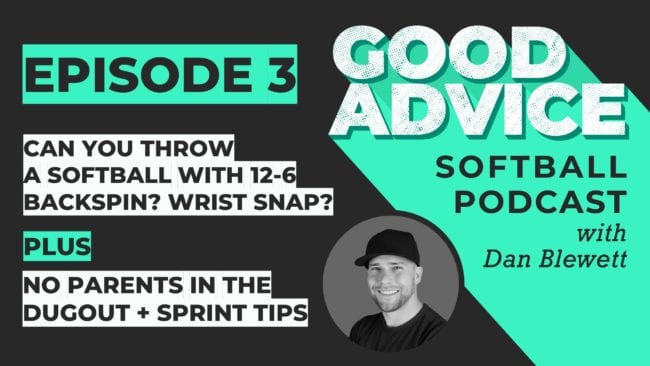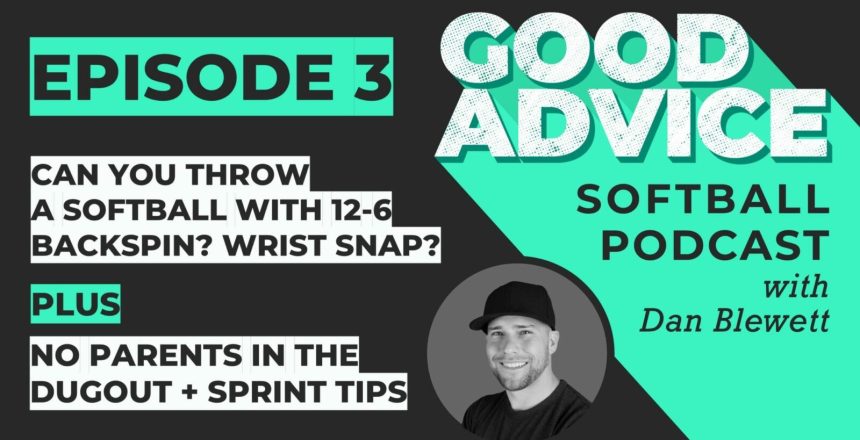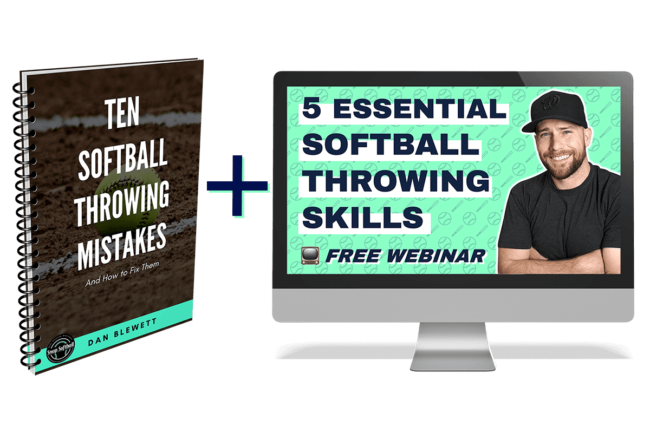*This article may contain product links which pay me a small commission if you make a purchase. Learn more.
Is it possible to throw with 12-6 backspin in softball? What about snapping the wrist? Coach Dan also covers parents in the dugout and sprint speed tips.
To submit a question for the Good Questions Q&A segment, make a voice recording and email it to Dan at hello@danblewett.com.
Want to support the show? Enroll in one of Coach Dan’s online throwing courses or his mental skills course. Use code GOODADVICE to save 20% on any course, just for being a listener.
Sign up for Dan’s Email list and get his free throwing eBook, and follow up with him on the interwebs: YouTube Channel | Twitter | Snapsoftball.com
Podcast: Play in new window | Download
Subscribe: Apple Podcasts | Spotify
EP3 – Full Transcript: 12-6 Backspin in Softball Throwing, Parents in the Dugout & Sprinting Tips
You are listening to the good advice, softball podcast. I’m Dan Blewett. And on this show, you’ll learn how to help the softball player in your life. Sharpen her skills, improve her mindset and find new confidence through softball ball.
Welcome back to good advice. I’m Dan Blewett and today we’re going to debunk a throwing myth that I don’t really know where this comes from, because it doesn’t really make sense when you really sit down and think about it. But for whatever reason, it, it has perpetuated this past week. I got this question twice.
I got it during my live seminar. And I also got it, um, during, uh, Oh, from Instagram. So this question was asked twice. It’s been on the front of my mind. And, uh, let’s, let’s talk about here. So this question is how [00:01:00] do I get better? 12 to six backspin because I want the ball to fly straighter, whether it’s to second base.
Like, I think I got this boast both times asked as a catcher. Um, and how can I improve my snap on my throat? So this is again where I think the baseball world shines a lot of light onto what softball players should be doing because the hardest throwing humans in the world, uh, are baseball players and specifically baseball pitchers.
Now. That’s not exactly true. There’s a lot of guys in the big leagues who are outfielders, who can throw a ball, you know, 105 from a Crow hop. But then again, there’s also still pitchers who can throw a hundred on the mound, which if they’re then Crow robbing, they could probably be up to like one 10, almost from the outfit with a run.
So I still stand by the baseball pitchers are the hardest throwers and here’s two things that they don’t worry about and that they don’t do. Number one, you don’t snap the ball. It just isn’t really a thing. So when you’re slowing down the [00:02:00] arm and obviously in major league baseball, there’s a lot of slow motion, video cameras that are capturing every game from every angle.
Your arm moves essentially as a whip together and you can’t control the individual segments. So as your arm lays back, as your torso starts to rotate and accelerate your arm from that point, your arm moves so fast that you cannot possibly control. And research has, has confirmed this. You cannot control the angle of your wrist or really when your fingers release from the ball.
So when people ask me, how do I improve my snap? I really don’t know how to answer it. I don’t even know what they’re talking about because for me as a baseball pitcher and I threw up into the mid nineties, I never ever thought about snapping a throw. It just was, it’s not a term in the baseball vernacular.
And when you slow down again, a baseball player pitching on high speed video, his forearm and his wrist are essentially locked. That’s not to say they’re stiff. Like they’re straight across. Like there might be some angle in their wrist, but it doesn’t [00:03:00] change as the arms accelerating. So there is no whip where you can like move your wrist and snap the balls.
You throw it. Even if you feel like that, when you’re playing catch, you’re essentially lying to yourself. Now, if you’re throwing 20 miles per hour and sorta throwing a dart, Sure you can feel your wrist, you know, bend and flex, but when you’re throwing hard using your whole body, you absolutely can’t. I think on slow motion, video and research in the baseball world has proven this.
So the idea of snapping the ball and you know, why doesn’t my daughter get more snap and I want to snap a release and we’re going to teach this, you know, there’s bent elbow, wrist, snap drills, we play catch it just, it just is kind of nonsensical. Um, and again, you cannot control your wrist at high speed.
So that’s my takeaway for that part of the question today. Number two, you can’t get 12, six backspin. You can get backspin. But it will always match the angle of your arm. So [00:04:00] baseball pitchers again, typically throw it a three quarter or high three quarter. That’s like standard arm slot. So three quarters is about 10 o’clock on the clock, face 10 or two, depending on which way you’re looking at it.
And high three quarters is maybe just a little bit higher, maybe like one 30, something like that. So. Really the term is it’s not about getting 12, six backspin and any coach that tells you that just doesn’t really understand the physics. And again, if, if you, if that’s what a misconception that you have today, I just want to politely debunk it.
So. The only way that you can produce 12, six backspin there’s two ways. Number one is by throwing from a 12 o’clock arm slot, which means putting your bicep. So you can raise your hand above your head right now, put your bicep until it touches your ear. So if you’re righty, you’re right. Biceps should be touching your right ear.
Does that feel like a normal position to throw in? I’m actually doing this right now, even though I’m not on camera. Does that feel like a normal position? No, it’s ridiculous. Also no one ever throws with their arms straight over their head right next to their ear. [00:05:00] That’s a 12 o’clock arm slot. And if you threw a ball from there, you would actually produce 12, six backspin because as your fingers.
Pushed through the center of the ball, the ball is oriented. So it’d be 12 to six. That’s the way it’d be rotating now in the real world, no one throws like that. So if you have good throwing mechanics, your arm is going to be somewhere around 10 or nine. If you’re a sidearm or 11, if you’re pretty high over the top and 11 is also still pretty steep and people don’t really throw that high that often.
So what ends up happening is that the only term you really need to think about is being in the center of the ball. Don’t think about being behind the ball. I do use the term being behind the ball, but really when I say behind the ball, it just means not on the side of the ball. Now on the inside of the ball is through the center of the ball being behind it in the center of it.
Those two terms are interchangeable. The only thing you want to think about as being in the center of the ball, that’s where you apply all your force so that you don’t put any weird spin onto it. And so when you’re in the center of the ball and your arm is at 10 o’clock. I guess the [00:06:00] direction of the spin, it’s going to be from 10 to eight.
Is that right? Let me think in my head. Yeah, it’s gonna be from 10 to eight. That’s the way the ball is going to go. And that’s good. You just want clean. Backspin where it just spins straight. It’s still backspin but because your arm is not at 12 six, it can’t be at 12. Six is going to be at ten eight. If you throw a sidearm, you can still essentially make the ball have backspin.
If you were to tilt, tilt your whole body, right? So it’s not gonna be backspin relative to the ground, but it’s, backspin relative to where you’re releasing it. You’re in the center of the ball and applying back spin. But because your arm is at nine o’clock, the ball is spinning actually sideways. Right.
But that’s all you can do. And that’s how the human body works. So, I don’t want you to, to think about trying to throw the ball 12, six, if you do this. Cause here’s the second way that you can throw 12, six, you have to drop your elbow and push your elbow to the front of your body. So then your forearm is straight up and down in the exact same [00:07:00] way that you throw a dart.
And that’s the way a lot of softball players throw. That’s the old quote, unquote, throwing like a girl, your elbow dips, your elbow goes in front of your body. And then you push with your forearm, which is again, while these risks NAB drill that we do so often in softball is such a bad drill because it teaches that it’s teaching 12, six backspin, which doesn’t exist in nature.
Go watch a major league baseball replay game on YouTube. Find some slow motion video of a pitcher from the catcher’s point of view. If you can find it. And you’ll see exactly what I mean. They throw with backspin coming from the angle of their arm. So that means 10 to eight or nine, nine to three. If they’re a side armor or 11 to seven, that’s the only way the best throwers in the world do it.
So please, if you have this idea of trying to get 12, six backspin. I hope today’s convinced you to drop it because it’s actually hurting your throat.
[00:08:00] Okay, so today’s 92nd mindset is for parents. So parents, here’s a couple tips that I want you to internalize from the college athletics world. So in college sports, you are relegated to a spectator. Uh, obviously after a game, you know, you can greet your kids, all that sort of stuff. When they’re done their team chores, whether that’s taking care of the field or, you know, talking with the media, whatever it is, depends on the size of the school and all that sort of stuff.But essentially when your kid gets to college, She is an adult and you are just a paying spectator. So in that there’s no sending them a Gatorade. There’s no like sneaking your head in the dugout. There’s no like waving down the dugout, even though obviously that’s so happens essentially. You don’t have any contact with your player during the game in college.
And this is something that you also want to start prepping for and by prepping for, I mean, doing when your kid is [00:09:00] in high school, whether that’s summer ball or high school ball, And even in middle school, you should get into the habit of letting your kids go and play. So that means so for me and my Academy, and we had softball, tennis, and we had a very strict, no parents for any reason in the dugout, unless your kid was injured.
So that meant do not send your, your, your son or daughter a Gatorade in the fifth inning. Don’t, you know, run over and hand them their lunch. Don’t come in and ask them a question. None of that stuff. And, and I know players at first were hesitant. They’re like, well, what if I run? I’m like, well, dude, pack a bigger cooler and take your eight bottles of water.
In the beginning of the game, you know, it’s two hours long. You can refill between games during double header, you know, whatever, but parents, the big thing is college coaches are watching everything you do. So they don’t want to see you coddling your child. They don’t wanna see you carrying her bag. They don’t want to see you really doing any of that parenting stuff.
They [00:10:00] want to see you being a spectator and they want to see the athlete being independent and a good team player and a good, um, coachable kid. That’s what they want to see. So even if this isn’t a team policy, I would strongly urge you to cut off all contact to your daughter during the game. That means send her with a big old cooler.
So she has everything she possibly needs during the game, you know, put a couple bandaids in there, whatever she could possibly need put in the cooler and make sure she has access to it. You know, if she has to have it right out of the dugout, cause it’s too big or whatever, that’s completely fine. But you shouldn’t be making contact with her during the game.
You should be cheering. You should be cheering on the team and that’s really it. You know, it’s your time decompress of the parents, cheer on everyone. Be a good, a good supporter, but essentially keep a forcefield between you and her. During the game, college coaches are going to appreciate it. And when they don’t know that you exist, that’s a good thing.
They want to know that you exist when they’re ready to [00:11:00] meet you and start to figure out what the family’s like. They don’t want to get any inkling of these helicopter parents, or even these lawnmower parents who are really, really close to their kids and can’t let them, you know, start to be independent and be adults.
So that’s my 92nd mindset for the day. Just start to let your kids go. Now, when you’re at the field, give them their space, give him their autonomy, let their coach do his or her thing.
Alright. It’s time for good questions. Our listener Q and a segment. Remember if you have a question you’d like answered on the show, please email a voice recording. To hello@danblewett.com. This is easy to do on your phone, through the voice memos app on iPhones or any voice recorder app on Android links to email me are in the show notes.
All right. And our question of the day is from Carson. My name is Carson Barbara, and I’m [00:12:00] from Illinois. And I had a little training question for you. What would you say some of the best exercises are for a softball player to do, to work on, um, speed and agility for both base running and fielding in general.
Thanks. All right. Thank you Carson. So remember, please send me an email with a voice recording and I’ll use it on the show. Hello@danblue.com. And I will read your question and I will answer it on the air. So, uh, today’s question obviously is about speed and agility. And here are my big three and they’re going to be pretty simple.
Number one, if you want to get faster, you need to get stronger. The equation for speed is not lots of fancy foot drills. It’s not ladder drills. It’s. It’s getting stronger so that every step that you put into the ground has more force behind it. Your body, you’re trying to push your body away from the earth, essentially.
So most athletes, when they want to get stronger early, when they don’t want to get faster. They’re usually kind of skinny and like just not very filled out. And they, they don’t have a lot of [00:13:00] force that they’re putting into the ground with each step. And they think that, you know, fast feet stuff and plyometrics are the answer.
Cause you know, a lot of people sell programs like that online and it seems really fun. And you know, for young kids, athleticism can be, can be built a little bit with foot speed drills. They’re not bad for them. But that’s not what any of the top sprinters in the world do, zero of them do that to get their speed up.
They are really muscular people. They’re very explosive people too, but the foundation comes from strength because if you don’t have any force to explode, then. It doesn’t matter. It’s the difference between a stick of dynamite and a firecracker, right? They both explode, but one has enough force to level your house.
And the other one has enough force where you could put in your Palm and not be even hurt by it. Right. So that sort of the analogy. So if you, your daughter wants to get faster, she absolutely needs to get stronger. And that applies to almost everyone because it’s so rare to see even a high school girl.
Who is really like, sort of filled out her [00:14:00] frame where she’s really strong for her size. It takes a long time, especially for female athletes who don’t have the testosterone levels of the boys. So number one is get stronger in the weight room and really devote yourself to that nine plus months of the year.
Number two is to actually go out and sprint the world’s best sprinters. They also sprint a lot it’s their sport, right? So if you’re sprinting only at practice or only during games, You’re not practicing sprinting, like your body’s not going to adapt to just from playing softball. So that means probably two or three times a week.
That means going out to a park, getting an, a nice dynamic warmup, getting your body really, you know, warm. So you’re not going to pull a hamstring or twist your ankle, do some form running drills, do all that stuff. That’s going to help improve your form. And then actually get after it sprint, like do maybe four to six 30 yard dashes, then four to six 40 yard dashes, four to six 60 yard dashes.
And these are ones where, when you’re trying to train for [00:15:00] speed, you want to give yourself a lot of rest. You should not be out of breath when you’re ready to start the next one. If you’re still out of breath and panting, it’s going to start to become more of conditioning and eventually more like a distance running because the energy systems that you use.
When you sprint versus when you jog, you’re very different. And this is just like animals. Like a cheetah can only sprint, you know, at its full speed for like seven seconds or something or 12 seconds. I’m not sure what the number is. That’s because they only have a little bit of fuel that they burn when they’re going full speed.
And when it’s out, it’s out, it’s like a car out of gasoline. Whereas the energy system, when you’re jogging is meant to be a slow burn, so you can keep going, but at a slow pace for a long time. So when you’re training for speed, it’s absolutely critical. That you are not winded for the next one. So that means if you’re running a 60 yard, which are hard and really booking it and giving it your best, it’s probably a two or three minute break for your next sprint, which seems like a long time, but that’s what you want to do.
And that’s what the best in the world do. So my number two tip [00:16:00] is actually go sprints, a mix of twenties, thirties, forties, and sixties are probably the best distances. And you’re probably going to do a total volume of somewhere between. Eight and 16 sprints per workout. And that’s gonna depend on the distances and all that sort of stuff, but devote two or three days a week, depending on your training, load, your game, schedule all that and make sure you’re actually sprinting consistently.
That will be the biggest thing you could possibly do. And then the third thing is, well, I mean, Essentially just find a good balance of power to weight ratio. So if you’ve got a little extra weight that means eat some healthier food, you know, maybe learn a little bit about nutrition. And unfortunately when you say you have two cars, if they both have the same exact engine in it, and one car is 2000 pounds and the other car is 3000 pounds, the 2000 pound car is going to go faster because it has a stronger, um, Weight to power ratio.
So with a being a really, [00:17:00] really high level sprinter, your weights or your, your weight to power ratio matters. And obviously this isn’t something that anyone wants to obsess over. You just want to say, okay, what are a couple easy things I can take away from my diet? So maybe it’s soda, or maybe it’s, you know, eat pizza once a week instead of twice a week, or just cut out a little bit of candy and then keep your regular training routine.
The same. And your body composition will change for the better over time. And that’s a good thing. No one should be obsessing about calories or counting calories, or even worrying about the scale or looking in the mirror that much, especially now when you’re a young athlete, but just making a couple extra healthy choices to swap in maybe to healthy foods for maybe two unhealthy foods per week can make a really good change over time because all these things are a marathon, not a sprint.
Even though we’re talking about sprinting making just small, easy changes that you can stick with for a long time are going to be healthy. They’re going to be mentally healthy. And they’re going to be good, long term longterm choices that you can stick with. [00:18:00] So again, if you just look around your, the things you eat and say, you take a food, a food diary for a couple of days, and you say, okay, you know, I had a couple sodas or had a couple bags of chips.
I’m just going to cut down to one soda per week, or, you know, one bag of chips per week or whatever it is. And I’m going to eat one extra Apple, and I’m a drink one extra glass of water instead, and that’s a great way to do it. And that absolutely will make a positive difference over time. And that could be another way to shave a couple tens of a second off your home the first time you’re home the second time.
Alright, so Carson, thanks again for the great question. And for you listening, please send me a voice recording again. It’s really easy to do on your phone. The voice memos app, send it to hello@danblue.com and I’ll answer it here on the show. Well, that’s all the good advice I’ve got for today. If you enjoy the show and would like to support me while also helping yourself.
Enroll today in one of my online softball courses, my she’s got a cannon throwing courses, come with pricing plans for any [00:19:00] budget. And my resolute athlete, mental skills course will help your daughter or team build the mindset of a champion enroll in any of my courses through the links in the show notes and save 20% with code good advice just for being a listener.
Be sure to subscribe to my weekly email list where you’ll get updates on all my new videos and episodes, nearly 4,000 people get my emails and you should to sign up for the link in the show notes. Lastly, who do you know, who can use some good advice? Please share this podcast with a friend, subscribe on iTunes, Spotify, or wherever you listen to podcasts and subscribe to my snap softball, YouTube channel, where you’ll find this podcast and hundreds of softball, instructional videos.
Back when I was a player, I was always thankful for good coaches and good advice. I’m Dan Blewett and I’ll see you next time.







